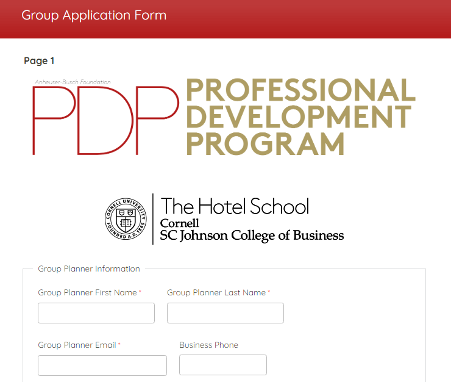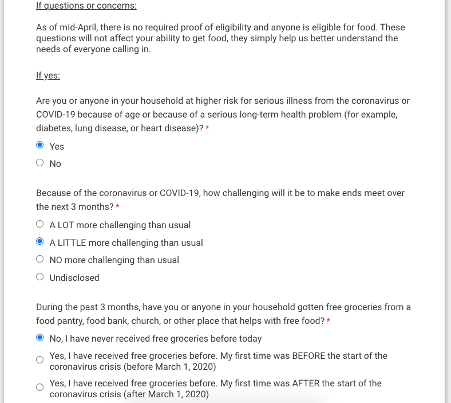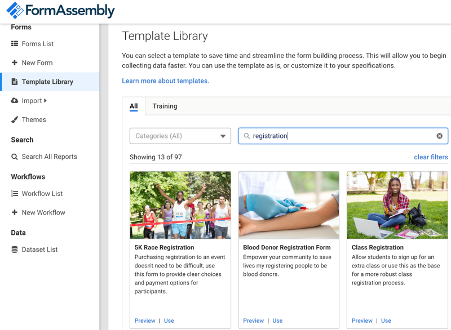As a Salesforce user, you understand the importance of collecting quality data. You know that the data you collect can help you understand and serve your customers and prospects better, which in turn drives the success of your organization.
However, entering all that data into Salesforce can be tedious, taking time and resources away from other important projects. On top of that, manual data entry is prone to human error, which ultimately limits its effectiveness.
In order to solve the data collection dilemma, many savvy Salesforce users have enlisted the help of robust, Salesforce-connected online form builders. In this blog post, you’ll learn four game-changing ways to use Salesforce-connected web forms at your organization.
#1. Application processing
Salesforce-connected web forms are the answer to simplified application processing, whether you’re collecting job applications, volunteer applications, education grant applications, or something else. By creating, collecting, and processing application forms through one easy-to-use form building platform that connects to Salesforce, you’ll be able to take more control over applicant information and eliminate busy work for staff members.
For example, Cornell University used FormAssembly’s all-in-one form builder and data collection platform to simplify complex application forms. With FormAssembly, Cornell was able to redistribute extra tasks from the Salesforce Developer team and promote productivity. The team at Cornell benefited from several Salesforce-connected form features, including:
- Prefill connector: Prefills forms with Salesforce data so that applicants don’t have to constantly fill out redundant information
- Validation rules: The form builder measures validity of specific responses to ensure that data is entered accurately and will feed into Salesforce correctly
- Repeatable fields: Repeatable fields can be used to create separate, individual records or merge data in Salesforce
#2. Understanding community needs
When you’re able to build customized web forms that funnel data directly into Salesforce, you’re also able to more easily learn crucial information about your customers or community. The goal of Salesforce is to manage customer relationships, and a Salesforce-connected form builder simplifies that process even further.
For example, the Greater Pittsburgh Community Food Bank used FormAssembly’s Salesforce-connected form builder to process home delivery requests for those who are homebound or at risk during the COVID-19 crisis. Because the form builder is so easy to use, staff at the Food Bank were able to put their form to use right away to help serve their community when they needed it most.
The organization built a form that creates a new contact record and opens reservation service records for individuals or households. The form used repeating sections and Salesforce object aliases in FormAssembly to offer dynamic recommendations. With this form, the Food Bank was able to better understand the needs of the community.
#3. Streamlining registration
When you’re planning an event or another program for your organization, collecting registration data should be the least of your worries. A Salesforce-connected form builder like FormAssembly makes registration a breeze and frees up time for you to focus on other event-related assignments.
FormAssembly’s extensive library of form templates includes dozens of premade forms for a wide range of use cases including class registration, donor registration, event registration and more. By connecting these forms with Salesforce, your registration data will be convenient and accessible for those who need it.
For example, Gameflow Interactive used FormAssembly to build an innovative shopping-cart-style registration form solution for classes. The class “checkout” system allowed students to register for multiple classes at once with real-time data flowing from FormAssembly into Salesforce behind the scenes. This streamlined the applicant process while simultaneously collecting purchase history data in Salesforce for easy future reference.
#4. Centralizing data
Centralized data is essential not only to save time and streamline processes, but also for security purposes. Collecting the data you need through a Salesforce-connected form builder helps to consolidate the information you need all in one place.
Before implementing FormAssembly and Salesforce, staff members at Give Something Back used a combination of spreadsheets and Access databases to manage nonprofit data. The organization wanted to forgo paper-based processing and keep necessary data all in one spot, so they chose to harness the power of Salesforce-integrated forms for data collection, management, and analysis.
Give Something Back benefited from FormAssembly’s easy-to-use Salesforce lookups and customization capabilities. The team also used FormAssembly’s prefill connector to send out text messages with prefilled forms.
Achieve all of this and more with FormAssembly
By implementing Salesforce-connected online forms at your organization, you’ll be able to easily funnel all of the data you collect through your web forms into your Salesforce instance. Being able to eliminate tedious manual data entry is invaluable—less time spent entering data into Salesforce means more time spent pursuing your major organizational goals.
FormAssembly is an all-in-one form builder and data collection platform with robust Salesforce integration. With FormAssembly’s Salesforce connector, users are able to:
- Prefill forms with data already in Salesforce
- Use forms to create, update, and lookup standard or custom objects
- Create Chatter posts
- Use Dynamic Picklists to bring in multiple choice answers directly from lookup results
- And so much more!
Although FormAssembly’s Salesforce connector is advanced on the backend, users don’t need advanced coding knowledge to create sophisticated, Salesforce-connected web forms of their own. Form creators have access to a collection of convenient, customizable form templates, making it easy to collect data for a wide range of use cases.
Ready to streamline Salesforce data collection? Sign up now to start building Salesforce-connected web forms with FormAssembly for free today!


